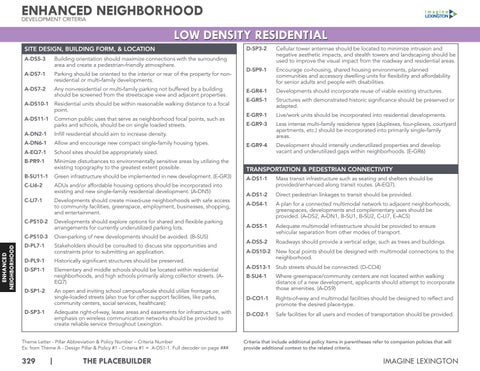ENHANCED NEIGHBORHOOD DEVELOPMENT CRITERIA
LOW DENSITY RESIDENTIAL
ENHANCED NEIGHBORHOOD
SITE DESIGN, BUILDING FORM, & LOCATION A-DS5-3
Building orientation should maximize connections with the surrounding area and create a pedestrian-friendly atmosphere.
A-DS7-1
Parking should be oriented to the interior or rear of the property for nonresidential or multi-family developments.
A-DS7-2
Any non-residential or multi-family parking not buffered by a building should be screened from the streetscape view and adjacent properties.
D-SP3-2
Cellular tower antennae should be located to minimize intrusion and negative aesthetic impacts, and stealth towers and landscaping should be used to improve the visual impact from the roadway and residential areas.
D-SP9-1
Encourage co-housing, shared housing environments, planned communities and accessory dwelling units for flexibility and affordability for senior adults and people with disabilities.
E-GR4-1
Developments should incorporate reuse of viable existing structures.
E-GR5-1
Structures with demonstrated historic significance should be preserved or adapted.
E-GR9-1
Live/work units should be incorporated into residential developments.
E-GR9-3
Less intense multi-family residence types (duplexes, four-plexes, courtyard apartments, etc.) should be incorporated into primarily single-family areas.
E-GR9-4
Development should intensify underutilized properties and develop vacant and underutilized gaps within neighborhoods. (E-GR6)
A-DS10-1
Residential units should be within reasonable walking distance to a focal point.
A-DS11-1
Common public uses that serve as neighborhood focal points, such as parks and schools, should be on single loaded streets.
A-DN2-1
Infill residential should aim to increase density.
A-DN6-1
Allow and encourage new compact single-family housing types.
A-EQ7-1
School sites should be appropriately sized.
B-PR9-1
Minimize disturbances to environmentally sensitive areas by utilizing the existing topography to the greatest extent possible.
B-SU11-1
TRANSPORTATION & PEDESTRIAN CONNECTIVITY
Green infrastructure should be implemented in new development. (E-GR3)
A-DS1-1
C-LI6-2
ADUs and/or affordable housing options should be incorporated into existing and new single-family residential development. (A-DN5)
Mass transit infrastructure such as seating and shelters should be provided/enhanced along transit routes. (A-EQ7).
C-LI7-1
Developments should create mixed-use neighborhoods with safe access to community facilities, greenspace, employment, businesses, shopping, and entertainment.
A-DS1-2
Direct pedestrian linkages to transit should be provided.
A-DS4-1
C-PS10-2
Developments should explore options for shared and flexible parking arrangements for currently underutilized parking lots.
A plan for a connected multimodal network to adjacent neighborhoods, greenspaces, developments and complementary uses should be provided. (A-DS2, A-DN1, B-SU1, B-SU2, C-LI7, E-AC5)
A-DS5-1
C-PS10-3
Over-parking of new developments should be avoided. (B-SU5)
Adequate multimodal infrastructure should be provided to ensure vehicular separation from other modes of transport.
D-PL7-1
Stakeholders should be consulted to discuss site opportunities and constraints prior to submitting an application.
A-DS5-2
Roadways should provide a vertical edge, such as trees and buildings.
D-PL9-1
Historically significant structures should be preserved.
D-SP1-1
Elementary and middle schools should be located within residential neighborhoods, and high schools primarily along collector streets. (AEQ7)
D-SP1-2
An open and inviting school campus/locale should utilize frontage on single-loaded streets (also true for other support facilities, like parks, community centers, social services, healthcare).
D-SP3-1
Adequate right-of-way, lease areas and easements for infrastructure, with emphasis on wireless communication networks should be provided to create reliable service throughout Lexington.
Theme Letter - Pillar Abbreviation & Policy Number – Criteria Number Ex: from Theme A - Design Pillar & Policy #1 - Criteria #1 = A-DS1-1. Full decoder on page ###
329
|
THE PLACEBUILDER
A-DS10-2 New focal points should be designed with multimodal connections to the neighborhood. A-DS13-1 Stub streets should be connected. (D-CO4) B-SU4-1
Where greenspace/community centers are not located within walking distance of a new development, applicants should attempt to incorporate those amenities. (A-DS9)
D-CO1-1
Rights-of-way and multimodal facilities should be designed to reflect and promote the desired place-type.
D-CO2-1
Safe facilities for all users and modes of transportation should be provided.
Criteria that include additional policy items in parentheses refer to companion policies that will provide additional context to the related criteria.
IMAGINE LEXINGTON
